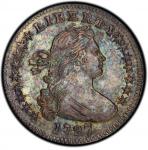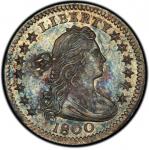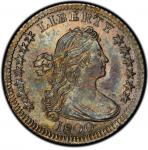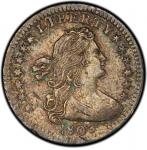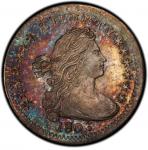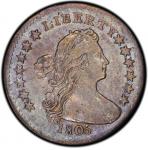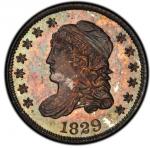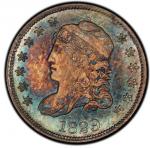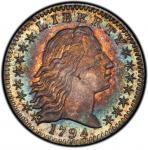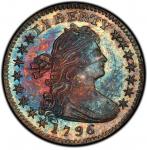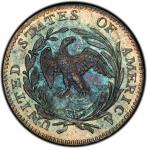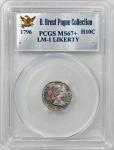"The head of Liberty … was designed by [Gilbert] Stuart, the celebrated portrait painter, at the request of the Director, as we learn from a relation of the family.” — James Ross Snowden, 1861A spectacular example, perhaps the most beautiful half dime in the D. Brent Pogue Collection and a strong contender for the most beautiful half dime of the Small Eagle type in existence. The toning is luxuriant, with bright blue and pink covering the central obverse while sparking gold surrounds at most of the periphery. The reverse is boldest at the center, blue and emerald, transitioning to gold and olive near the rims. The luster cartwheels around both sides are complete and reflective, giving this the appearance of a glittering jewel. The strike is definitive, showing every fine detail the engraver could have hoped would appear on his finished product: every hair strand, every eagle feather, each leaf detail and more. Every star shows a center but star 3, nearly every denticle is fully brought up, and a wire rim is even visible in some areas, most notable near 3:00 on the obverse. This extraordinary detail is made all the more impressive by the state of the dies, now twice clashed, with the clash marks visible all over obverse and reverse. A network of fine obverse cracks have evolved as well. The one from the rim across the two lower points of star 6 is the most notable, stretching to the ribbons as described by Logan and McCloskey. Other smaller ones are visible too: below star 1 to the lowest curl, above star 1, above star 4 downward on a diagonal to the hair. The reverse is also clashed and cracked, with a large break at the foot of the first T in STATES, stretching above to the rim and below to behind the eagles head. Smaller cracks are seen from the base of the second S in STATES to the leaf below, below the wing of the eagle on the right side of the reverse near the leaf tip below, and from the side of the same wing into the wreath. The surfaces are immaculate, as this lofty grade would suggest, and finding anything that would keep this coin from the asymptotic state of numismatic perfection is a tall order even with a strong glass. Imagining a finer specimen, or one more beautiful, or one better struck, requires license beyond the capacity of reason.There is no finer example of the LIKERTY variety, so-called because of the distinctive broken B punch in LIBERTY atop the obverse. This variety is also known as, simply, the Normal Date, a contrast with the 1796/5 overdate. This is the more available of the two half dime varieties of the year, but in absolute terms, especially as compared to later issues, it can be called rare. This is the single finest half dime dated in the 1790s to have been certified by PCGS. Further, the only finer Draped Bust half dime, of this Small Eagle reverse type or the 1800-1805 Heraldic Eagle reverse type, is the MS-68 (PCGS) 1800 half dime that is also in the Pogue Collection (technically the last year of the 18th century, but popularly the first year of the 19th). The only sale to have a comparable beauty might have been the 1945 F.C.C. Boyd Collection sale, the “Worlds Greatest Collection” that included two 1796 half dimes that were said to be gem Uncirculated coins. This piece may be one of them (lot 190 was described as “there are die lines on obverse and reverse. Another gem coin, Uncirculated”), though the photographs were too poor to be of modern use. They sold for $90 and $97.50. This one brought roughly two thousand times as much when it last sold 25 years ago.
“This magnificent specimen, with all devices in minute detail, should bring a record price.” — Norman Stack, 1969A duplicate of the preceding, this is an exquisite early die state striking from these dies, as fully and finely detailed as could be hoped for, free of clash marks and showcasing the designs as they were intended. The fields are reflective on both sides, lustrous and toned, bathed in pale blue and violet with light gold at the peripheries and an area of deep amber above Libertys head. The eagle is as well detailed as an anatomical rendering, and the wreath that surrounds it looks sculptural under a glass despite its small scale. Some faint ancient hairlines are seen on the obverse, with two parallel and nearly horizontal hairlines in the lower right obverse field limiting the grade, but both sides maintain gem quality technically and exhibit magnificent eye appeal. The thin die crack between TA is in its earliest state, and the fine crack right of the final S in STATES is just two disconnected spalling sites, not yet cracked together. The dies have not yet clashed, a process that exacerbated these smaller existing cracks significantly. Though comparison with the previous lot is daunting, on its own this specimen stands as the third finest example of this variety seen by PCGS since their inception in 1986.Described in the 1969 catalog of the R.L. Miles sale as: “Brilliant Uncirculated, with full proof-like surface. Undoubtedly a Specimen Striking. By far, finer than the example in our Milton A. Holmes Collection, October 1960. This magnificent specimen, with all devices in minute detail, should bring a record price. The $1,200 reflected in the Guidebook will probably be doubled.” The coin brought more than twice that. Just as the example offered in the previous lot could be “Worlds Greatest Collection” lot 190, this example may be lot 188 from the same sale, an early die state described as “a superb coin, Uncirculated.” It assuredly is both of those things.
A thrilling coin."" -- Q. David Bowers, 1979A simply remarkable half dime, displaying a visual appeal and sharpness of strike that is unmatched among specimens from these dies. The reverse is boldly reflective, showing extreme contrast between the bright lustrous fields and the exquisitely rendered devices. The eagle is anatomically complete, with a fine eye, full chest feathers, well defined feet and talons, and crisp nostril and tongue. The reverse is mostly brilliant with peripheral areas of champagne gold and deeper plum. The obverse is thoroughly lustrous, not reflective but full of lively frost. The strike is exceptional, though some spare vestiges of central planchet adjustment are visible at the center of Libertys hair. The fields have an overall even gold tone, deepening to blue and violet in some areas near the rim. A short curved lint mark is present at the furthest point of star 15. Study reveals scant hairlines and just a single flaw, a short scratch off the bust in the field near star 14. The overdate is easy to see under low magnification.A rare coin blessed with a magnificent (albeit confused in earlier appearances) provenance. That this coin is from both the Garrett (1979) and Parmelee (1890) sales is incontrovertible: it is plated in both, with exact agreement in every detail. However, the Garrett sale lists this as being from the Maris Collection, sold in 1886, with no mention of a Parmelee provenance.It appears that the provenance as given in the Garrett sale is just a typographical error; the previous lot in Garrett, lot 228, had a Maris pedigree, and it looks like the pedigree for that coin was mistakenly inserted into the wrong lot description.The sale of the Parmelee Collection was the greatest numismatic auction of the 19th century. The sales of the Garrett and the Eliasberg collections were the greatest numismatic auctions of the 20th century. That this coin would grace both the Parmelee and Garrett cabinets should help explain its importance: it is beyond a doubt the finest example from these dies, two points better than the Eliasberg specimen (earlier from the legendary Clapp Collection). It has been in the best high grade type set ever formed, the Jimmy Hayes Collection, and the best collection of the coins of 1796 ever formed, the John Whitney Walter ""Mr. 1796"" Collection. It now adds a further laurel, having joined the D. Brent Pogue Collection, the most remarkable assemblage of high grade early United States coins ever brought into one cabinet. This was described as ""a thrilling coin"" in the Garrett sale. This may be the most thrilling half dime of the entire Draped Bust / Small Eagle type."




